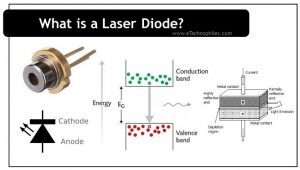Last updated on March 26th, 2024 at 06:10 pm
A laser diode is a semiconductor device that emits light when an electric current is passed through it. The light emitted by it is very intense and narrowly focused, making it an ideal source of light for use in optical fiber communications and laser printers.
In this article, we will discuss the uses, construction, and their working. We’ll also look at the differences between a laser diode and an LED.
Table of Contents
These are also known as semiconductor lasers, junction lasers, junction diode lasers, or injection lasers.
What is a laser diode?
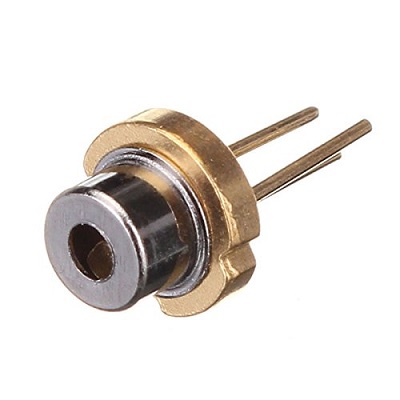
LASER stands for “Light Amplification by the Stimulated Emission of Radiation”. It is an optoelectronic device. It converts electrical energy to light energy. Lasing conditions are created by stimulating atoms using electric current. A narrow beam of light is emitted through it which is of a particular wavelength.
What are optoelectronic devices? Optoelectronic devices convert electrical signals into optical signals or vice versa. When an electrical current is applied to these materials, they emit light. Conversely, when exposed to light, these materials generate an electrical current.
Typically, only a minimal spectrum of visible, infrared, or ultraviolet wavelengths are covered by the emission. The PN junction of the semiconductor acts as a laser medium in Laser diodes.
Note: These diodes generate wavelengths ranging from 810 to 1064 nm. Laser light can penetrate 2 to 3mm (or more) into soft tissue. It varies with wavelength and type of tissue.
Symbol
The symbol is given in the figure below. It is identical to an LED. The arrows (projecting outward) indicate the emission of light.
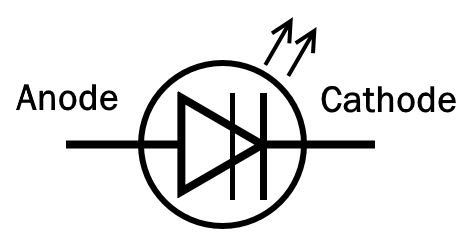
Uses
It generates coherent, monochromatic, and precisely directed light beams. This property of lasers is effectively utilized in different fields. Let’s have a look at laser applications in different areas.
Telecommunication
- In fiber optic communication, laser technology helps to transmit light signals.
Medical applications
- Surgical removal of tissues
- The laser beam is injected into the wounds, which also stops bleeding in blood-rich tissues like the gums or the female reproductive system.
- Ophthalmologists use it for laser surgery
- In the treatment of kidney stones
- Cosmetic laser treatments are used for hair and wrinkle removal
- They are also used to treat dental problems
Industrial applications
- Mechanical drills to make holes
- Cutting, welding, wire stripping, etc
- Laser scanners to read barcodes
- Laser printers
- Laser torches
Surveying
- Pulsed laser radar for finding the distance between planets.
- To measure accurate distance on battlefields in military applications
- For contact-less measurements
High energy lasers
- For nuclear power weapons
Construction
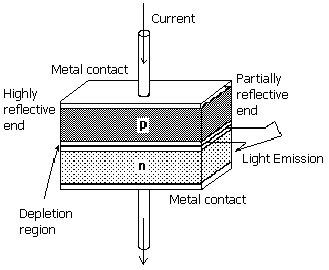
Their basic structure is similar to that of a light-emitting diode (LED). In these diodes, two layers of Gallium arsenide are used to make the PN junction. One layer is doped with trivalent impurities for p-type semiconductors and the other is doped with pentavalent impurities for n-type semiconductors. The point at which these layers meet is called the PN Junction.
A depletion region gets formed at this junction due to the recombination of electron-hole pairs after application of forward voltage. The front surface acts as a reflecting surface since it is fully polished. In contrast, sides are partially polished and act as partially reflecting surfaces.
Materials used in laser diodes
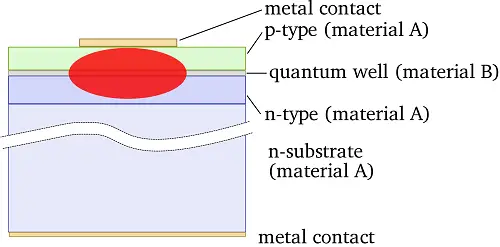
They may contain different materials based on the application they are used in. Different materials with corresponding emission wavelengths and their applications are given in the table below.
| Laser diode material (active region / substrate) | Typical emission wavelengths | Typical application |
| InGaN / GaN, SiC | 380, 405, 450, 470nm | data storage |
| AlGaInP / GaAs | 635, 650, 670nm | laser pointers, DVD players |
| AlGaAs / GaAs | 720–850nm | CD players, laser printers, pumping solid-state lasers |
| InGaAs / GaAs | 900–1100nm | pumping EDFAs and other fiber amplifiers; high-power VECSELs |
| InGaAsP / InP | 1.2–2.0μm | optical fiber communications, sensing, spectroscopy |
| AlGaAsSb / GaSb | 1.8–3.4μm | defense, sensing, spectroscopy |
Working principle
When an electric current is applied to the p-n junction, it causes electrons and holes to be injected into the junction. These injected carriers then combine and emit photons, which form the laser beam.
We know that free electrons in the conduction band have a higher energy level than holes in the valence band. On this recombination, the laser diode releases energy in the form of photons. The emitted light from a laser diode is a coherent beam. Due to the avalanche effect, more atoms release more photons during the photon motion. Thus the generation of more and more photons causes a very powerful laser beam.
Now, look into the steps involved in producing a coherent beam. There are three steps for this; absorption of energy, spontaneous emission, and stimulated emission.
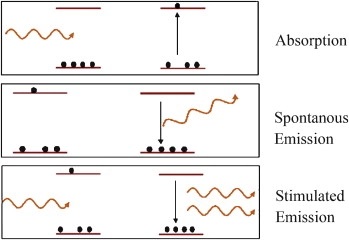
Absorption
When voltage is applied to the laser diode, electrons in the valence bond absorb energy to break this bond. These free electrons move to higher energy levels called the conduction band. Empty spaces created by these electrons are called holes.
Spontaneous emission
After absorption of energy, many free electrons jump to the conduction band which is a higher energy state. The holes remain at the valence band which is a lower energy state. These free electrons will recombine with holes by releasing extra energy in the form of photons(Light).
Stimulated emission
Incident or external photons force free electrons in the conduction band to recombine with holes in the valence band. This is called stimulated emission. Every incident photon will produce two additional photons during stimulated emission.
Note: There is a threshold value for a laser diode and it is a crucial feature. Emission is weaker below this threshold value, so a certain amount of power must be applied, to turn them on.
Characteristics
Lasers have unique characteristics which can be utilized for a variety of applications. These are:
- Coherent (The emitted light has the same wavelength)
- Monochromatic (The emitted light is narrow and contains a single color)
- Highly directive beams
- High intensity
- Lasers have the same frequency and phase
- Laser light can travel long distance
- Portable due to small size
- Long operating hours
- Low cost
Is a laser diode the same as an LED? What are the differences?
Laser diodes and LEDs are not the same. The only similarity between them is that both emit light energy on the recombination of electron-hole pairs. The table below gives the major differences between them.
| Characteristics | Laser | LED |
| Acronym | Light Amplification by Stimulated Emission of Radiation | Light Emitting Diode |
| Principle of working | Stimulated and spontaneous emission | Spontaneous emission |
| Characteristics of emitted light | Coherent and Monochromatic | Low-cost and economical |
| Bandwidth | 1MHz to 2MHZ | 10 to 50THz |
| Light conversion efficiency | Approx 70% | Approx 30% |
| Width of Junction | Narrow | wide |
| Driving current | 5 to 40mA | Low-cost and economical |
| Cost | High cost and used in the specific application. | Low cost and economical |
FAQs
Why is gallium arsenide used over silicon?
Silicon produces energy in the form of heat on recombination. But gallium arsenide produces photons or light. Hence gallium arsenide is used in the construction of laser diodes.
What is laser diode and photodiode?
Laser Diode: Emits light through stimulated emission in a semiconductor structure. Used in CD players, pointers, etc.
Photodiode: Converts light into electrical current when exposed to photons in a semiconductor structure. Used in solar cells, light detectors, etc.
What are the advantages of Laser Diode?
Laser diodes are advantageous due to their:
1. Low power consumption
2. Economical operation
3. Longevity
4. Portability
5. Stability
